
 Image: Matt Smith
Image: Matt Smith
At a glance
Expert’s Rating
Pros
Attractive designBright, colorful imageExcellent motion clarityOfficially supports both AMD FreeSync and Nvidia G-Sync
Cons
Stand is still too largeModest contrast ratioHDR is available, but disappointing
Our Verdict
LG’s UltraGear 27GR38Q-B is an alluring and reasonably priced pick for PC gamers looking to move to 240Hz.
Price When Reviewed
$499.99
Best Prices Today: LG UltraGear 27GR83Q-B
RetailerPriceLG$349.99View Deal
LG’s midrange Ultragear gaming monitors are a popular choice, and it’s clear why. They provide good image quality and motion clarity at a reasonable price. Now, LG has upped the ante with the new UltraGear 27GR83Q-B, a 27-inch gaming monitor with 1440p resolution and a 240Hz refresh rate—a big leap from older models, like the popular 27GP83B-B, which had a maximum of 165Hz. It’s a worthy upgrade, though not without competition.
Further reading: See our roundup of the best gaming monitors to learn about competing products.
LG UltraGear 27GR83Q-B: The specs
The LG Ultragear 27GR83Q-B’s most important specifications are its most obvious. It’s a 27-inch, 1440p monitor with a 240Hz refresh rate. This combination has risen as the new go-to standard for midrange gaming monitors in 2023, replacing older 27-inch, 1440p monitors with a 144Hz or 165Hz refresh rate.
Display size: 27-inch widescreenNative resolution: 2560×1440Panel type: IPS LED edgelitRefresh rate: 240HzAdaptive Sync: AMD FreeSync Premium, Nvidia G-SyncHDR: Yes, HDR 10Ports: 2x HDMI 2.1, 1x DisplayPort 1.4, 1x USB-B upstream, 2x USB-A downstream, 3.5mm audio jackSpeakers: NonePrice: $499.99 MSRP, $399.99 typical retail
Importantly, the LG UltraGear 27GR83Q-B provides official support for both AMD FreeSync Premium and Nvidia G-Sync. Many monitors are technically capable of this, but it’s uncommon to see official certification for both at this price point—and it’s nice to see LG take the extra step.
LG UltraGear 27GR83Q-B: Design
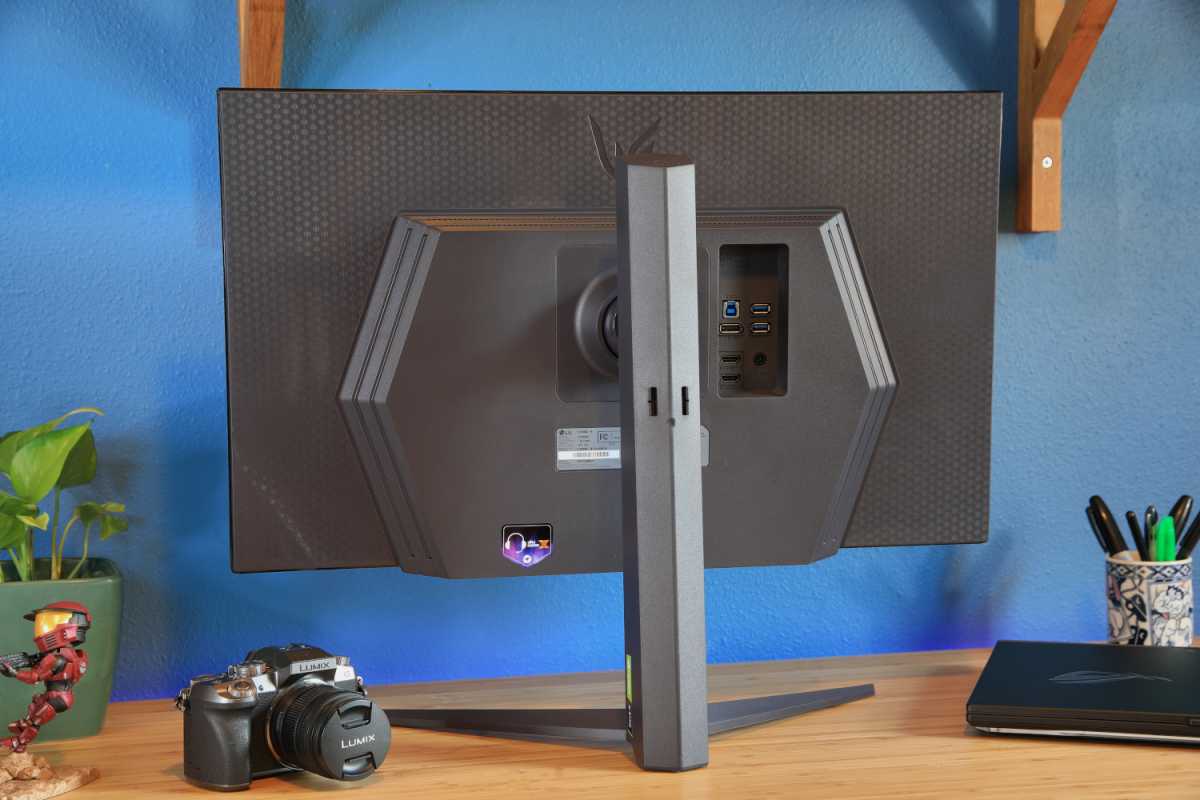
LG UltraGear 27GR83Q-B (back side).
LG UltraGear 27GR83Q-B (back side).
Matt Smith
LG UltraGear 27GR83Q-B (back side).
Matt Smith
Matt Smith
The 27GR83Q-B is similar to LG’s 27G95QE-B OLED gaming monitor. It has a thin display attached to a wide, octagon-shaped box that contains the monitor’s internal hardware and ports. The 27GR83Q-B’s panel is not as thin as the OLED model but still strikes a handsome profile.
Material quality is great, too, with sturdy textured plastics that feel premium when handled. LG also ditches the garish red flair of older UltraGear models, so the 27GR83Q-B looks less out-of-place in a home office.
LG still opts for a wide-legged stand, however, which is a bit annoying. This design looks dramatic and keeps the monitor stable, but consumes a lot of desk space. That’s bad news if you have a small desk. The stand adjusts for height, tilt, and pivot (but doesn’t swivel). The monitor supports 100x100mm VESA mounts, so it can be used with third-party monitor stands and arms.
Gamers are sure to be pleased by the LG UltraGear 27GR83Q-B’s 240Hz refresh rate. It delivers smooth, silky motion with minimal motion blur.
LG UltraGear 27GR83Q-B: Features and menus
A pair of HDMI ports and one DisplayPort provide the LG UltraGear 27GR83Q-B a total of three video inputs. That’s a modest amount for a monitor in this price range. However, LG takes the important step of using HDMI 2.1 ports, which means all three video inputs can handle the monitor’s full resolution and refresh rate. That’s a perk not all monitors in this price range achieve. The less expensive HP Omen 27qs, for example, sticks with HDMI 2.0.
USB connectivity is slim. The monitor has a single USB-B upstream port, which drives two USB-A 3.2 downstream ports. All ports are found on the back of the monitor, as well, so adding and removing USB devices is a bit of a hassle. USB-C would be appreciated but, in LG’s defense, that’s a rare feature in gaming monitors sold below $500.
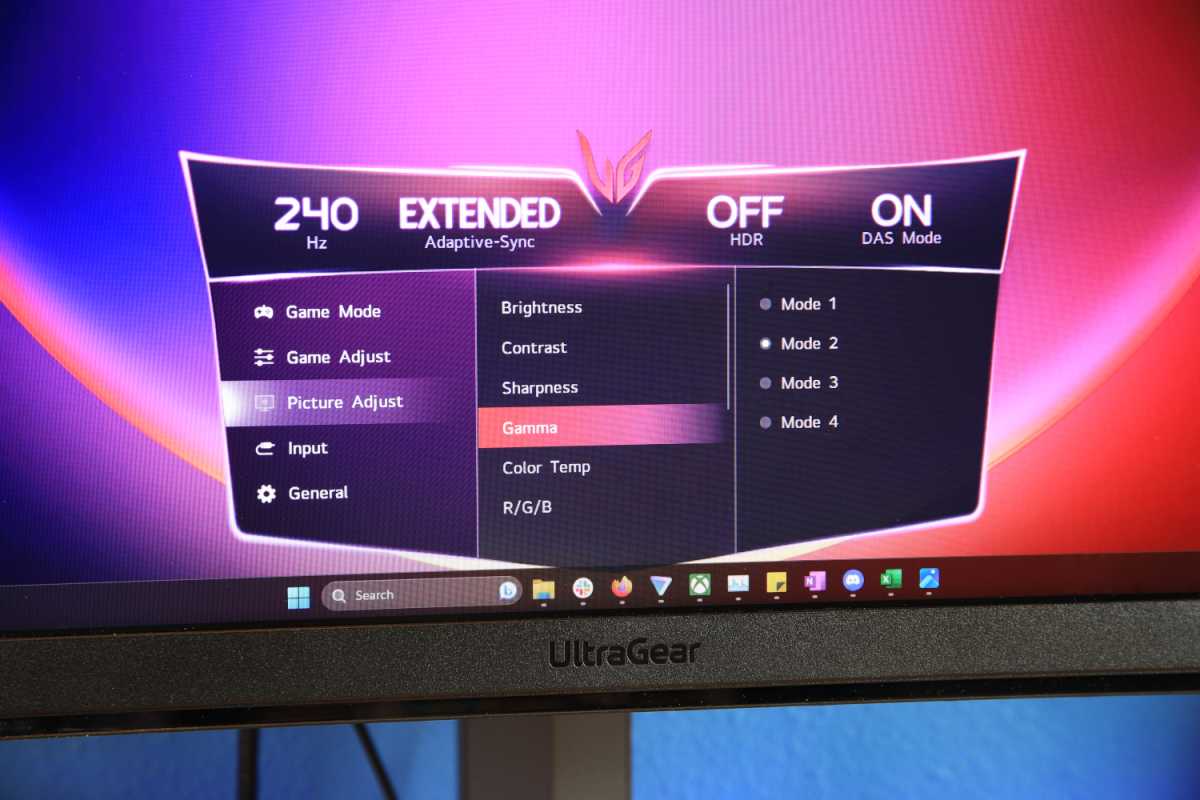
LG UltraGear 27GR83Q-B’s menu system.
LG UltraGear 27GR83Q-B’s menu system.
Matt Smith
LG UltraGear 27GR83Q-B’s menu system.
Matt Smith
Matt Smith
A joystick located on the lower lip provides access to the monitor’s on-screen menu system. The joystick is easy to use and responds quickly to user input. The menu system is classic LG, with lists of options scattered across a shield-like backdrop. LG’s menus are easy to understand and provide a good range of image quality customization, which includes color temperature, gamma, and six-axis color hue and saturation adjustment. The monitor has an sRGB mode, but none of its gamma or color temperature adjustments claim to meet a specific target, instead using vague terms like “warm” and “cool.” This is standard stuff for a gaming monitor, and the overall range of adjustment is good, if not exceptional, for the 27GR83Q-B’s category. There are also a few gaming features such as an on-screen crosshair, a black stabilizer mode (which makes enemies in shadows easier to see), and an FPS counter.
Speakers aren’t included in the 27GR83Q-B, which is also true of most gaming monitors. BenQ’s Mobiuz monitors, such as the EX270QM, are the only option for gamers looking to cram decent audio in their display. That monitor is at least $200 more expensive than the LG at current prices, however, and its image quality is roughly similar.
How is the LG UltraGear 27GR83Q-B’s SDR image quality?
The LG UltraGear 27GR83Q-B is built for speed more than image quality, but that doesn’t mean it shouldn’t look good. Fortunately, the monitor delivers good SDR gaming image quality overall, though it has the downsides typical of most gaming monitors sold below $500.
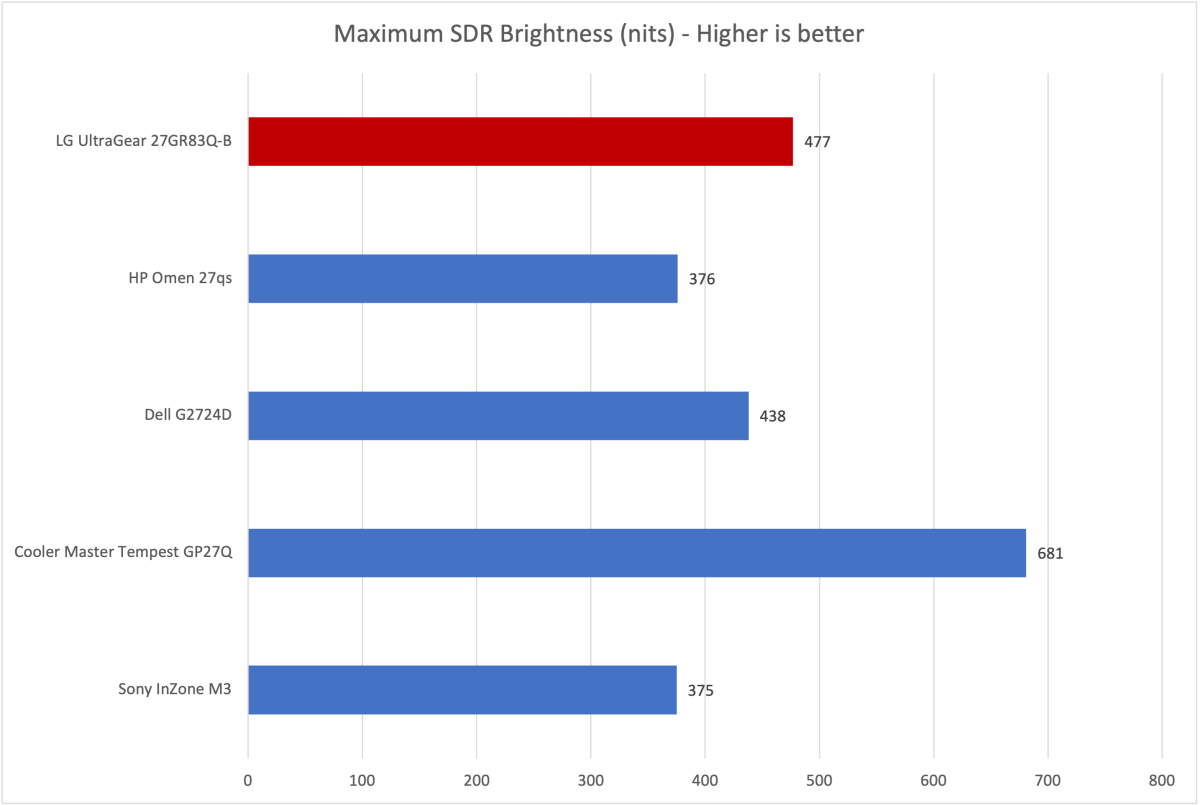
Matt Smith
Matt Smith
Matt Smith
LG gets off to a strong start in brightness, where the monitor delivers a maximum brightness of 477 nits. That’s higher than similar alternatives and way more than enough for comfortable viewing even in a well-lit room with large, sunny windows. The Cooler Master Tempest GP27Q, a budget Mini-LED monitor, is even brighter—but it’s hard to imagine a situation where the added luminance is called for (outside HDR, at least).
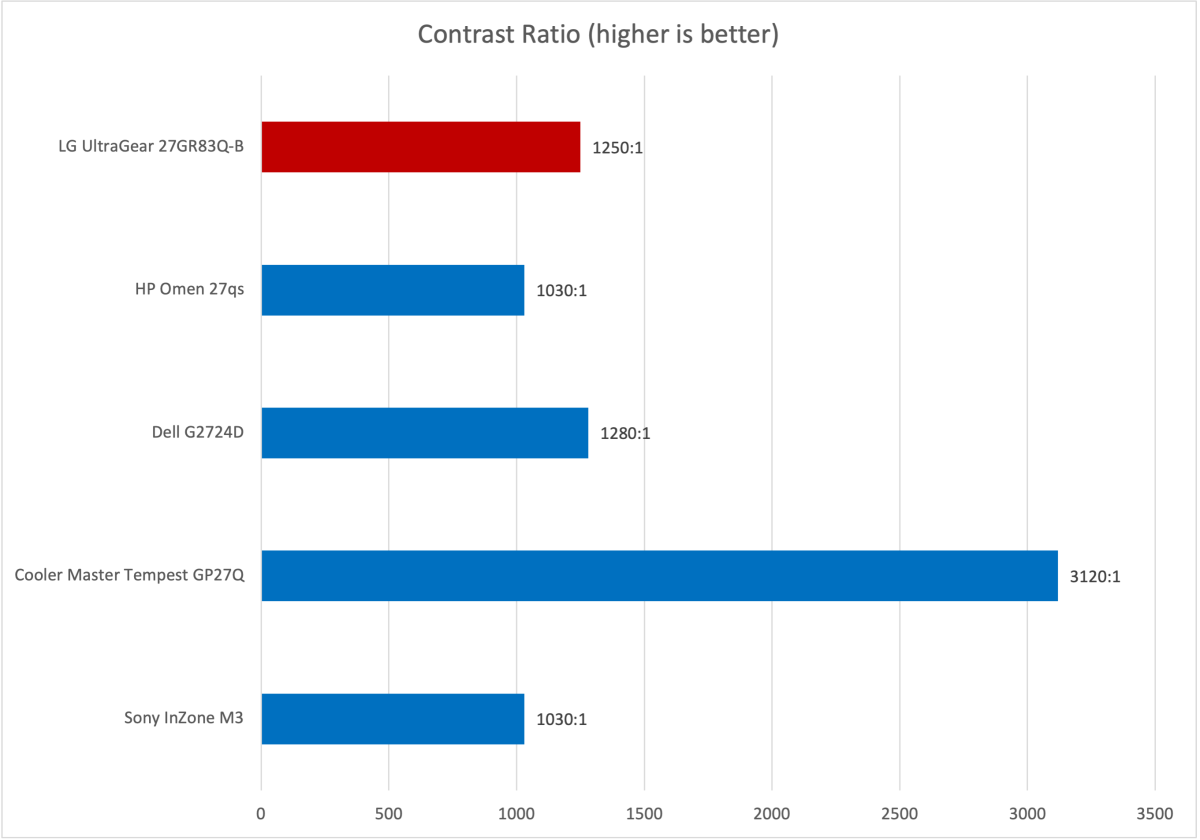
Matt Smith
Matt Smith
Matt Smith
The contrast ratio comes in at a respectable measured maximum of 1250:1, which is towards the high end for an IPS gaming monitor with an LED edge-lit backlight. The 27GR83Q-B can provide a convincing sense of depth in a lit room, but suffers the inability to properly darken dim areas of the screen. As a result, dark content can look flat and washed-out. This is a flaw common to gaming monitors in this price range.
The Cooler Master Tempest GP27Q once again leaps out as a price-competitive Mini-LED alternative. It has a dynamic backlight consisting of 576 dimming zones that can turn on and off independently, which boosts the contrast ratio. It only has a 165Hz refresh rate, though—you win some, you lose some.

Matt Smith
Matt Smith
Matt Smith
Color gamut is another strong, though not mind-blowing, result for the 27GR38Q-B. The monitor’s color gamut spans up to 92 percent of DCI-P3, which would’ve been rather wide a few years ago, but is so-so today. However, most competitors once again score similarly—or, in the case of the HP Omen 27qs and Sony InZone M3, fall behind.
The 27GR38Q-B’s color gamut, though not spectacular, is a fine fit for gaming. Most PC games don’t require a large color gamut to enjoy a visual experience true to the creator’s intent. The gamut is also wide enough for many content creators with less demanding color needs. I wouldn’t recommend it if you’re working on the art for L’Oreal’s new ad campaign, but most YouTubers, Twitch streamers, and TikTok stars won’t see a problem.
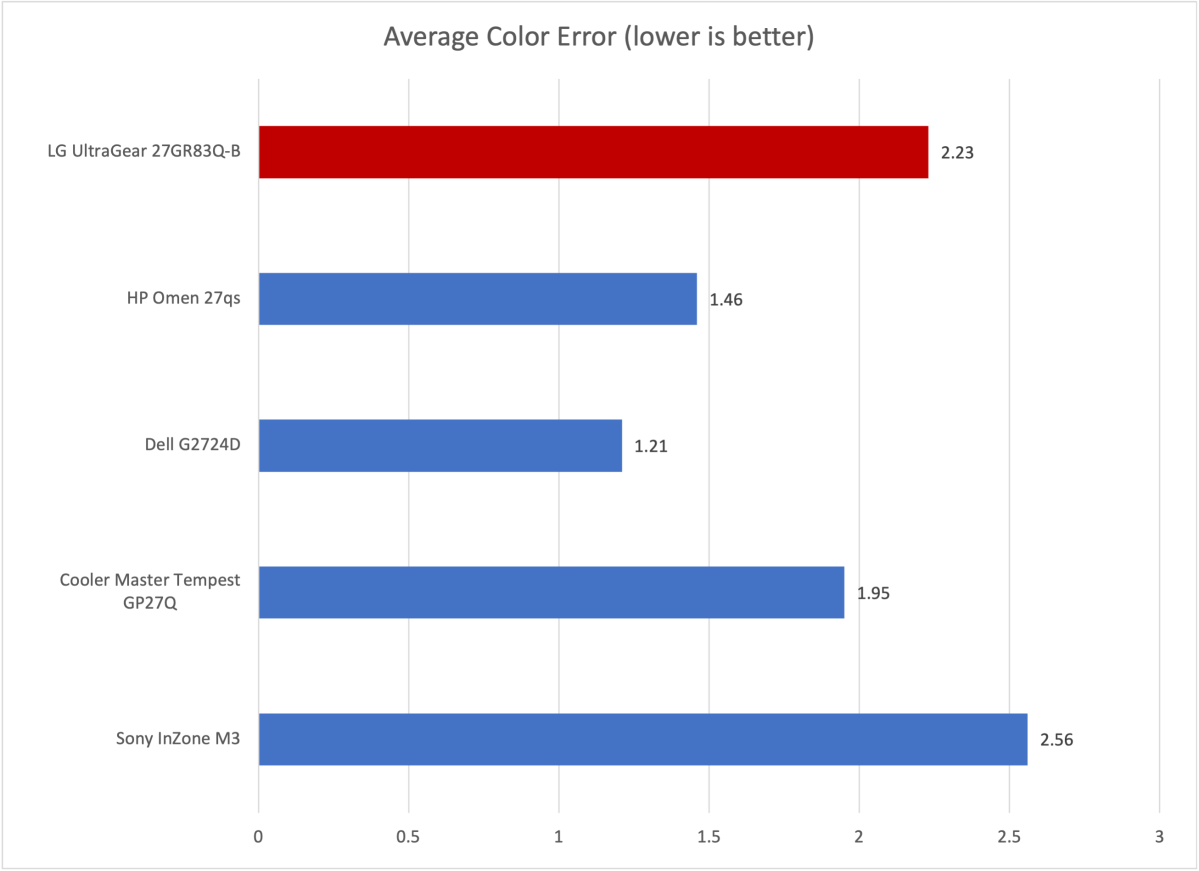
Matt Smith
Matt Smith
Matt Smith
It’s a similar story in color accuracy. The monitor’s out-of-box color accuracy could be better, and it does fall behind a few competitors including the Dell G2724D and HP Omen 27qs. However, the color accuracy available here is fine for PC gaming, and the differences would be difficult to notice outside of a direct A-to-B comparison.
The LG also performed well in gamma and color temperature tests. It scored a gamma curve of 2.2, which is our preferred target and indicates content shouldn’t look too bright or too dark. It also served up a color temperature of 6300K which, though a bit warmer than the target of 6500K, isn’t far off the mark.
Sharpness is also strong. The monitor’s 27-inch 1440p panel packs about 109 pixels per inch. That’s a nice upgrade over a 27-inch 1080p panel, which packs just 82 pixels per inch. The added pixel density offers a crisp font and provides a sharp, crisp look in games. A 4K monitor would look sharper still, of course, but also place more demand on your GPU. Very few gaming PCs can render modern games at 4K and 240 frames per second, so 1440p resolution is a better fit for a 240Hz monitor.
The LG Ultragear 27GR83Q-B’s overall SDR image quality doesn’t leave the competition in the dust, but the monitor posts strong results across a wide range of tests and avoids any major problems. OLED monitors with 1440p resolution and a 240Hz refresh rate are more attractive, but also twice as expensive. The 27GR83Q-B performs well for the price.
How is the LG UltraGear 27GR83Q-B’s HDR image quality?
LG supports HDR on the UltraGear 27GR83Q-B—but, as is often the case with less expensive monitors, the experience isn’t ideal.
The monitor achieves a maximum HDR brightness of 507 nits. That’s fairly respectable for a monitor in its category, but certainly far below the preferred minimum of 1,000 nits. The lack of brightness is a problem, as it means the 27GR83Q-B can’t display the range of luminance necessary to satisfy even the least demanding HDR content. That, in turn, will crush out detail in bright scenes.
Color gamut and contrast are problems, too. The color gamut, while fine for SDR content, is certainly limited for HDR. Colors may look different when presented in HDR, but not necessarily better. The limited contrast, on the other hand, is a problem when viewing scenes that pair small bright objects on an otherwise dark scene. These highlights lack the separation and impact visible on a display with a better contrast ratio.
All of this is typical for a sub-$500 gaming monitor—I can’t think of any that are notably better. Gamers looking for good HDR on a more reasonable price should consider Mini-LED monitors like the Cooler Master Tempest GP27Q, the Innocn 27M2V, and the RedMagic 4K Gaming Monitor.
How is the LG UltraGear 27GR83Q-B’s motion performance?
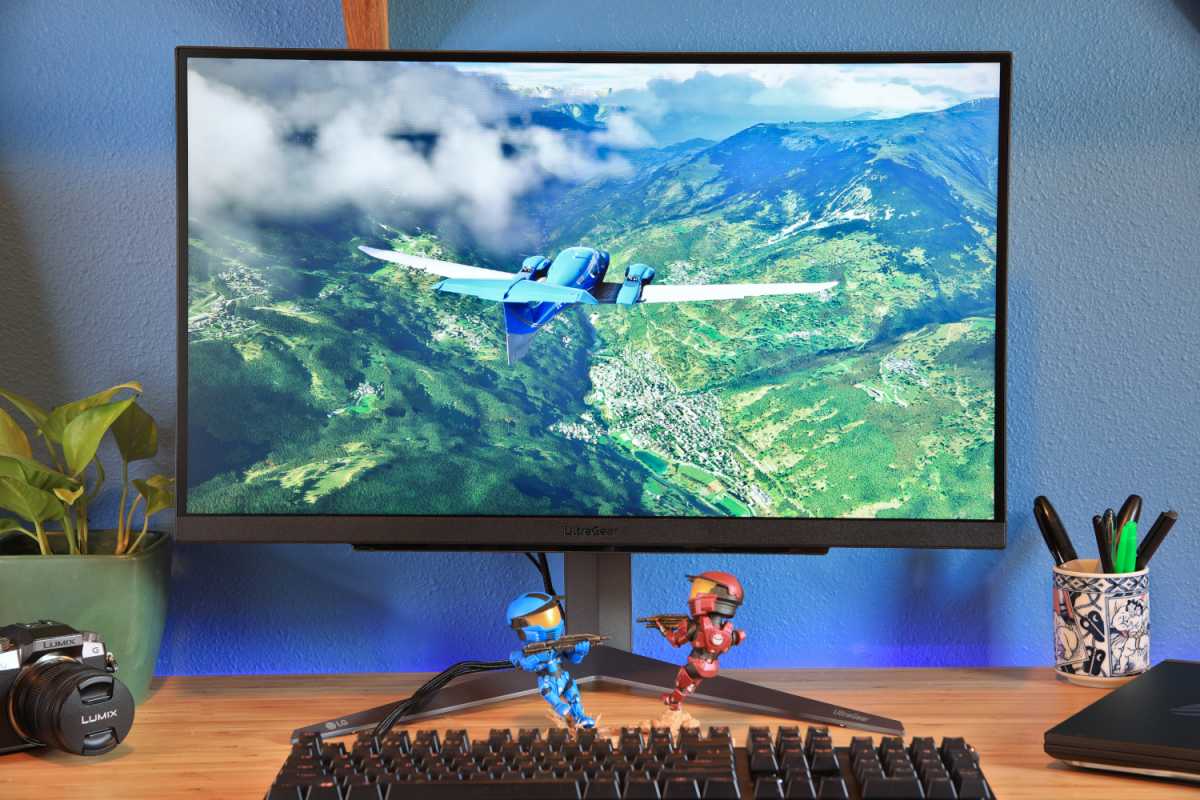
The LG UltraGear 27GR83Q-B’s 240Hz refresh rate provides buttery smooth visuals.
The LG UltraGear 27GR83Q-B’s 240Hz refresh rate provides buttery smooth visuals.
Matt Smith
The LG UltraGear 27GR83Q-B’s 240Hz refresh rate provides buttery smooth visuals.
Matt Smith
Matt Smith
Gamers are sure to be pleased by the LG UltraGear 27GR83Q-B’s 240Hz refresh rate. It delivers smooth, silky motion with minimal motion blur.
Mentioned in this article
Alienware AW2524HF
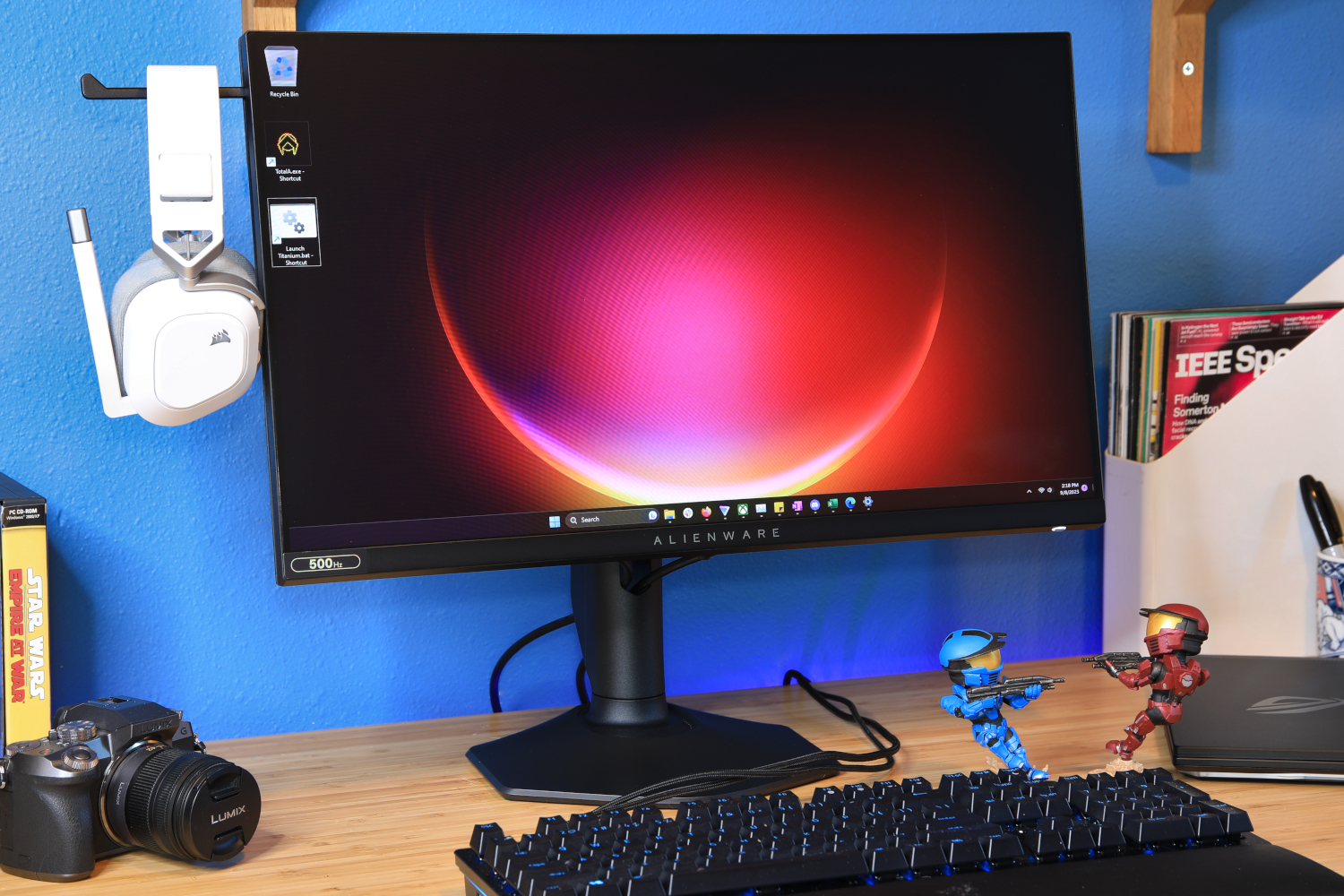
 Read our reviewPrice When Reviewed:$649.99Best Prices Today:$649.99 at Dell
Read our reviewPrice When Reviewed:$649.99Best Prices Today:$649.99 at Dell
A refresh rate of 240Hz isn’t the highest available today—that honor goes to the 500Hz Alienware AW2524H—but it’s rather impressive. Scrolling test images from League of Legends and DOTA 2 showed great detail in both terrain and character silhouettes. Character names and hitpoint bars were generally readable, too, though details might be hard to make out depending on the action at hand.
The monitor’s excellent motion clarity is sweetened by the 27GR83Q-B’s official support for both AMD FreeSync Premium and Nvidia G-Sync. In truth, most monitors that handle one standard can also handle the other, but most manufacturers don’t bother to leap the hurdles required for official certification from both AMD and Nvidia. I’ve always found this a bit lazy, and I’m glad to see LG do the extra legwork.
Monitors like the 27GR83Q-B are quickly making 240Hz the new go-to standard for high-refresh PC gaming. There’s nothing wrong with 144Hz, but 240Hz is now affordable and provides a wonderful boost to motion fluidity.
Should you buy the LG UltraGear 27GR83Q-B?
LG’s midrange UltraGear gaming monitors have earned a reputation as a solid, no-fuss choice for gamers looking to buy a good gaming monitor that’s not ridiculously expensive. The new UltraGear 27GR38Q-B lives up to, and even bolsters, that reputation. It’s attractive, well-built, and provides good image quality with excellent motion clarity. LG’s only problem is the competition: HP’s Omen 27qs, for example, delivers similar image quality at a lower MSRP of $399.99. The LG is arguably the more alluring option, however, at least when its price is cut to $400 (which is already happening at some retailers).
Best Prices Today: LG UltraGear 27GR83Q-B
RetailerPriceLG$349.99View Deal
Author: Matthew S. Smith
Matthew S. Smith is a freelance technology journalist with 15 years of experience reviewing consumer electronics. In addition to PCWorld, his work can be found on Wired, Ars Technica, Digital Trends, Reviewed, IGN, and Lifewire. Matthew also covers AI and the metaverse for IEEE Spectrum and runs Computer Gaming Yesterday, a YouTube channel devoted to PC gaming history.
Recent stories by Matthew S. Smith:
Pixio PX248 Wave review: A monitor for fashion, flair, and clarity on a budgetBest portable monitors 2024: Displays that go with youBest ultrawide monitors 2024: Let’s get large




